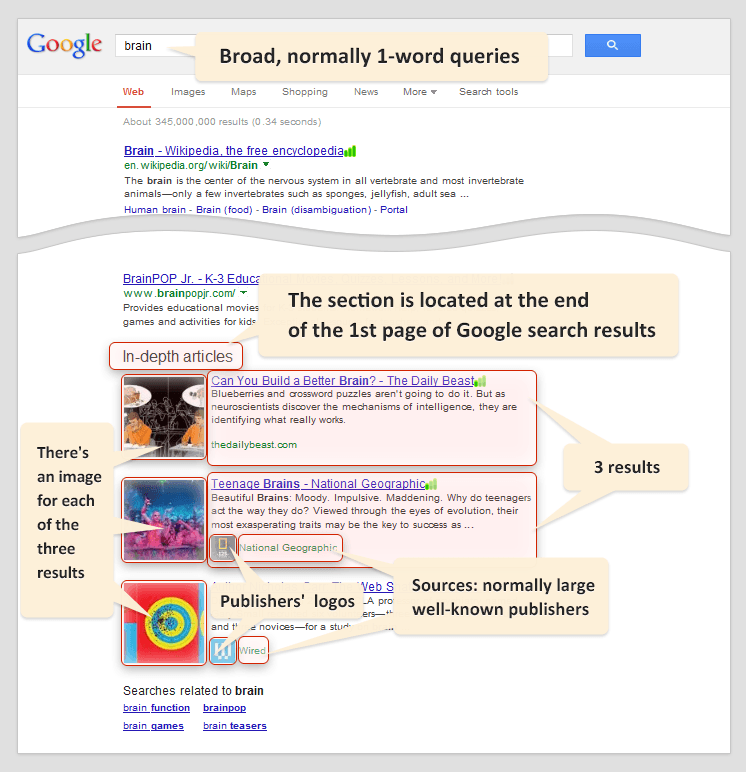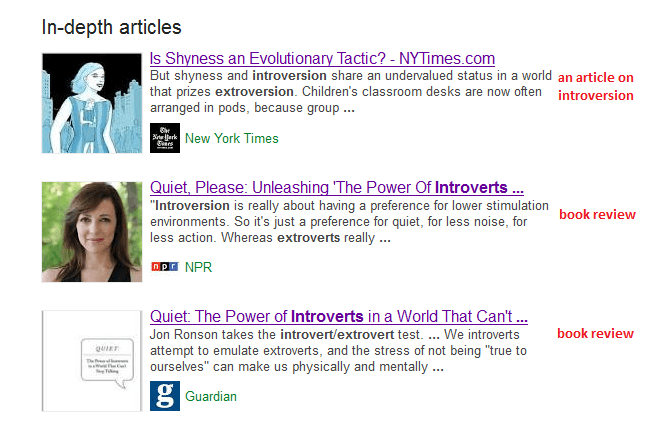Google In-depth articles is a new search result option introduced by Google in August 2013. Along with News, Images and a number of other familiar search blocks, In-depth articles is a new search section located at the bottom of search results and features 3 search results, accompanied by images:

In-depth articles were introduced to feature well-researched write-ups on broad topics, thought-provoking content that remains relevant months and years after publication. Research shows that 10% of all Google searches are searches on broad topics, so this feature apparently comes in handy for users.
But how about SEOs? Does introduction of the new section create any extra opportunities for them? Opinions range from that you should invest into In-depth articles to that they are not worth chasing.
In this post I’ll share the main takeaways of Google In-depth articles to help you see if you can make anything out of them.
Keywords that suit In-depth articles
To begin with, In-depth articles do not show up for all search queries. They are available for very broad terms only.
The majority of keywords that have an In-depth articles option are 1-word terms. It’s very rare that you’ll find this section available for 2 or more words: for example, they’ll be an In-depth articles section for “advertising,” but there won’t be one for “per-per-click advertising.”
I wrote down some keywords I found In-depth articles for. Then I ran a quick check with Rank Tracker to see how “difficult” these keywords are in terms of SEO.
As you can see from the data provided below, these keywords are quite appealing from the SEO standpoint. The number of searches to competition ratio (KEI) suggests these are keywords that are likely to bring you enough Visits while it might be not that hard to compete for them.
 A Rank Tracker project for broad keywords that Google chooses to show In-depths articles for. Data is provided on the Number of Searches, Competition and KEI (Keyword Efficiency Index), which is a rough estimate of how easy it is to make your site rank for this keyword.
A Rank Tracker project for broad keywords that Google chooses to show In-depths articles for. Data is provided on the Number of Searches, Competition and KEI (Keyword Efficiency Index), which is a rough estimate of how easy it is to make your site rank for this keyword.
However, keywords featured in the In-depth articles section are very broad indeed. And that’s the major problem with them: they’re very poorly-targeted and cater for different search intents.
Search intent for broad keywords in the In-depth articles section
Broad keywords, the ones that show up in the In-depth articles section, are very unclear in terms of search intent. When people search for “cheese” in the In-depth articles section, do they look for history of cheese, types of cheese, recipes or cheese production technologies?
It might be any of these options, and here’s what they get in reality:

In the example above, In-depth articles results for “cheese” are somewhat unexpected:
- A personal story on improving cooking habits.
- An article on body building. “Cheese-grater abs” includes “cheese” as part of a metaphor. Thus, it’s actually a search result that doesn’t suit this section.
- Several recipes.
What this example shows is that In-depth search results – in reality – are often far from well-researched write-ups on broad topics. And in my opinion the problem is the nature of search queries rather than the algorithm behind the In-depth search results. Broad notions can imply totally different meanings, thus search results are answers to totally different search intents.
Broad keywords or queries that fit In-depth articles are more a kind of the first iteration in search routine, something that people type into the search bar from the top of their heads. With further iterations, they become more specific, use more words, but they no longer get In-depth search results.
Here’s another example, which is actually a rare example when there’s an In-depth articles section for a 3-word search query, which is “introverts and extroverts:”
- A New York Times article on the nature of shyness and introversion by a Susan Cain, an author of a best-selling book about introverts.
- Review of Susan Cain’s book by NPR, a large media organization.
- The Guardian’s review of Susan Cain’s book.

It’s kind of strange that all the three results revolve around one author and one book, which might be judged as that Google is not providing its users with different viewpoints. Yet in my opinion this case is closer to the concept of In-depth articles, which is about well-researched write-ups on broad topics.
The next example is a perfect illustration of the multi-intent problem in relation to In-depth articles.
Do people searching for big bang mean the TV show or the concept in physics? In any case they get both:

Are In-depth articles results personalized?
I wondered how far Google goes with personalization in case of In-depth articles. I mean does the search engine take into account if a user shows more interest to either science or the show when forming the In-depth articles section?
I.e. will a TV show fan have less physics in the In-depth articles results?
To find that out, I ran a small experiment. For three days, I opened lots of stuff about the TV show logged into my Google account.
However, the search results didn’t change: I still had 1 show and 2 cosmology results in the In-depth articles section. One example is not enough, yet it suggests that at this stage In-depth articles results are not largely personalized.
How well pages that are now in the In-depth articles are optimized
Next I was curious to know how well pages that show up as In-depth articles are optimized for this section.
What I did was the following.
I took 3 keywords that have an In-depth articles section for them. To make the research more diverse, I took keywords of different length from the examples above: cheese, big bang and introverts and extroverts.
I first looked how well the pages were optimized for these keywords, i.e. were there any keywords used in the title, meta description, alt tags; what the keyword density was in the body text and in link anchor text; and also what the Google PR was. This data was collected with the help of WebSite Auditor.
Also, Google recommends webmasters adding the following signals to help the algorithm recognize In-depth content better:
– schema.org “article” markup
– authorship markup
– rel=next and rel=prev for paginated articles
– information about the organization’s logo
I checked if pages that already show up in the In-depth articles have the recommended markup.
I also added the word count data to get an idea about the length of the in-depth content.
The results for on page optimization level, recommended markup, word count and Google PageRank for pages that show up in the In-depth article section are summarized in the table below:

Click to the table to enlarge it
The data in the table suggests that on page optimization level for the In-depth article results is relatively low and even zero in some cases: i.e. author didn’t get there because they stuffed their content and on page elements with keywords. Google PR doesn’t play a huge role as well: in many cases it was n/a.
As for Google recommendations, schema.org article markup seems to be pretty irrelevant, as well as rel=next and rel=prev. On the other hand, all articles but one had some kind of authorship markup. Also, all the resources provided their organization’s logos.
Summing it up: main takeaways regarding Google’s In-depth search and your chances getting there
- In-depths articles are a new section in search results recently introduced by Google.
- In-depths articles show up for broad, normally 1-word, queries. 2-word queries are relevant for this type of search results only if it’s a deeply-rooted phrase like global warming or social media. In-depth articles are very rare for phrases consisting of more than 2 words.
- Google provides instructions on how webmasters can make their content appear in the “In-depth article” feature. A look-up on several page that are currently in the In-depth articles section suggests adding authorship markup and organization’s logos is what has been done in the majority of cases.
- Well-known publishers are given a higher priority when content from different sources is considered for inclusion. Google states that quite explicitly (“In addition to well-known publishers, you’ll also find some great articles from lesser-known publications and blogs”) and the example in this article prove it as well.
- Keywords that cater for the In-depth articles section normally have a high Keyword Efficiency Index. Each case is different, but this data suggests that some of these keywords might be not that difficult from the SEO standpoint.
- Keywords that cater for the In-depth articles section are very poorly-targeted and meet a variety of search intents.
- In-depth articles are supposed to feature well-researched write-ups on broad topics. However, the section is currently a bit of a mess as it includes articles that might be a better fit for news or normal organic search results.
So are In-depth articles worth or not worth it?
In the beginning of my article I mentioned that some experts are all for investing into In-depth articles, while others think they’re a waste of time, and I wanted to see for myself whether they’re worth it.
Judging from the examples I analyzed, hitting or not hitting In-depth articles is a matter of luck, so you should evaluate your chances anyway. Start with looking for relevant broad keywords that have an In-depth articles section for them. For example, if you run a vegan blog, you’ll see that In-depth articles show up for “vegetarians”.
See if you already have any 2,000+ word content that is a good match for at least one of the search intents. If you don’t have anything that is a match, see if it makes sense for you writing it.
Then enhance your in-depth content with the recommended markup and see if it works out.
It’s as simple as that: if your project and content is a match for the In-depth section, chances are you hit it. And it’s not a huge investment of time and energy to try that out because if you make it you’ll get a new source of traffic you haven’t had access to before.
And is your content a match for the In-depth articles section? Or perhaps you’ve already hit it? What do you think of the new search section as a Google user? Share your ideas in the comments below!




